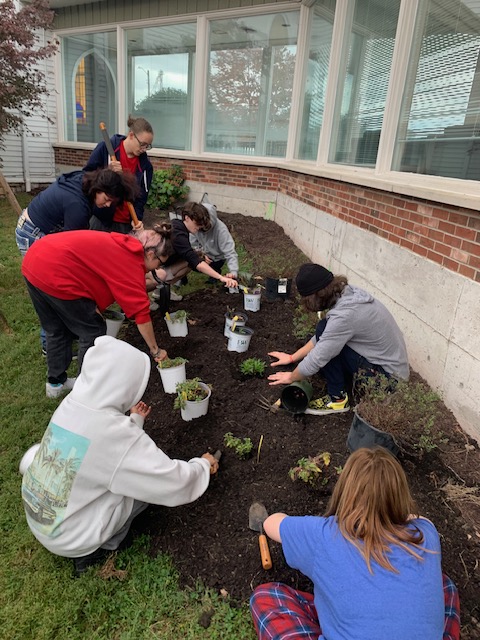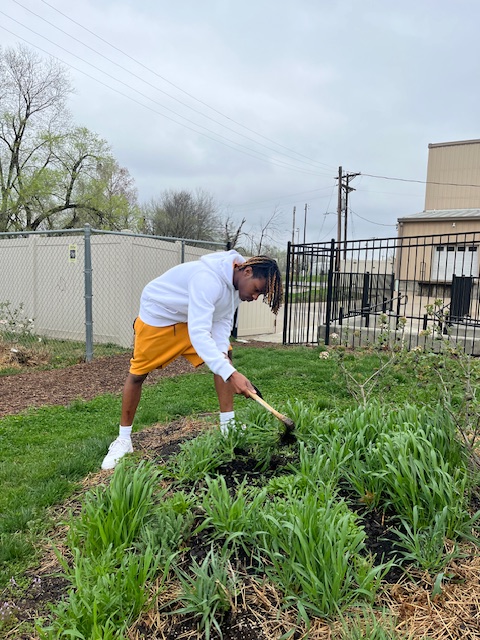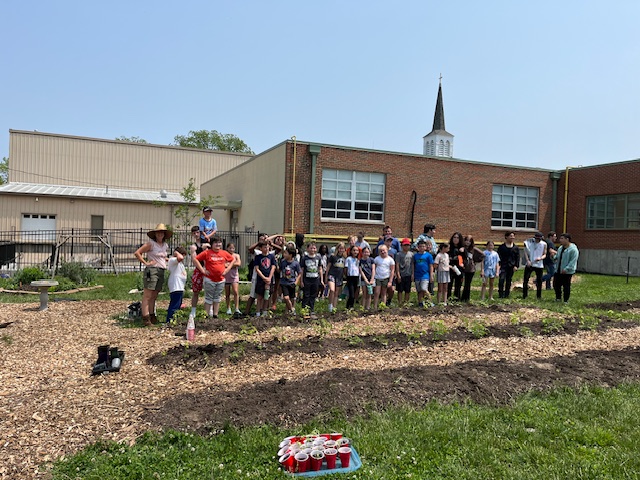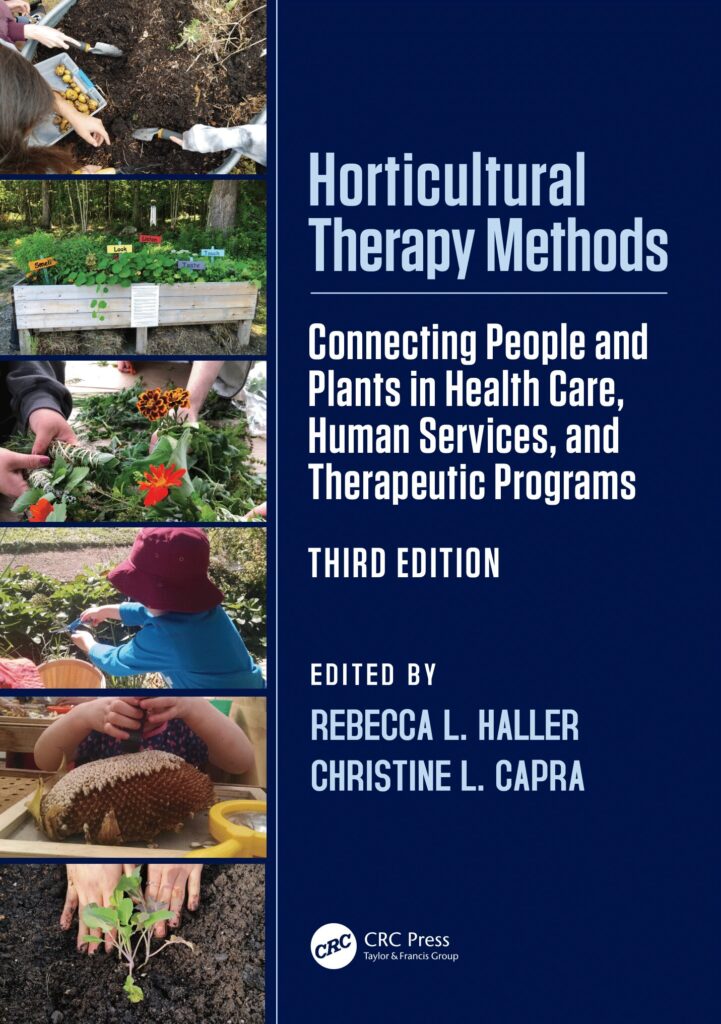
Program Manager, HT Institute
2025 Spring Newsletter
Horticultural Therapy is making an impact on people’s lives.
Read more about how it’s happening.
HTI Director’s Note: The Third Edition Textbook!
By Rebecca Haller, HTM

Hi readers.
Woohoo! It’s finally out. Horticultural Therapy Methods: Connecting People and Plants in Health Care, Human Services, and Therapeutic Programs was written to describe the processes and techniques for effective horticultural therapy practice, including treatment planning, goals, activities, therapeutic approaches, and documentation. The first and second editions have been used in the US and around the world and translated into Spanish and Mandarin. Now a third edition is ready for you.
An essential guide for teaching or studying any aspect of the use of horticulture for therapeutic purposes, your current work will also be enhanced by using the strategies illustrated. The third edition is available from CRC Press Taylor & Francis Group.
This book has several important enhancements over the second edition and is recommended even if you already own an earlier edition.
Here are a few of the key additions.
- New exhibits and photos of a wide variety of subjects from horticultural therapy practice.
- Exhibits on horticultural therapy in the field from practitioners representing an array of program types, with accompanying discussion questions by Marsha Vaughn, PhD, LMFT.
- A new chapter, ‘Cultivating Respectful Relationships in Horticultural Therapy,’ by Jay S. Rice, PhD, LMFT.
- Revised examples of treatment objectives and what to measure.
- Additional forms and programs created and used by horticultural therapy specialists.
- Chapter summaries and resources for further reading.
- Updated content throughout chapters.
We wrote and edited the book to enhance the professional practice of HT/TH and hope it will contribute to quality work around the world.
Thanks to all the contributors – it is a useful and inspiring book because of you.
Program Profile: Cultivating Growth: The Pearce Produce Garden Program
By Amy Nau
About Our Program

The Pearce Produce Garden sits quietly along the back side of the old school building, but its impact on our students and community resonates far beyond its physical boundaries. From the roadside, you can see wildflowers emerge in early spring as all other perennials start to show their beautiful return. Vegetable production rows are centered, with native and wildflower garden beds surrounding our produce. As you wind alongside the school building you meet our grief garden. Nestled in between the school and a historical old church (which students now use the chapel for music and poetry therapy), is our courtyard grief garden where each garden bed represents one of five stages of the grieving process– denial, anger, bargaining, depression and acceptance. We offer an additional flower bed in the grief garden for students and staff to plant seeds or plants in honor or memory of someone or something. As you meander from the grief garden courtyard, you come to the side of the church, where two over-full garden beds contain strawberries and an array of fragrant and medicinal herbs. Students love to make tea with dried herbs, and use fresh herbs for flower bouquets, culinary delights and more.
At Pearce Hall Alternative High School, our garden program serves as both an educational platform and a therapeutic environment where students can develop practical skills, build confidence, and connect with the natural world and each other to bring a moment of joy and wellness to their day.
What We Do

Our garden program nurtures more than just plants—it cultivates student growth through hands-on learning experiences. Students participate in all aspects of garden management, from soil preparation and planting to maintenance and harvesting. Throughout the seasons, they learn to grow a diverse array of:
- Vegetables for sustainable food production
- Herbs for culinary and medicinal purposes
- Native plants that support local ecosystems
- Flowers that beautify our campus and attract pollinators
Horticultural Therapy Goals
Program goals are tied to Pearce Hall’s mission and vision and include increasing pre-vocational work skills, increasing positive sensory experiences, increasing social and emotional management, enhancing the quality of life and sense of purpose, and increasing joyful moments for students throughout the school day.
Students come to horticulture class twice per week, for the school year. Each session is between 30 minutes and 1.5 hours in length.
Beyond academic learning, our garden serves as a therapeutic space where students work toward personal growth goals including:
- Developing patience and nurturing skills through plant care
- Building concentration and mindfulness through garden tasks
- Enhancing emotional regulation through nature connection
- Fostering responsibility through ongoing garden maintenance
- Cultivating pride and self-confidence through visible achievements
- Developing social skills through collaborative garden projects
Activities and Learning Opportunities
Students engage in a variety of garden-related activities throughout the year:
- Seasonal planting and harvesting
- Seed starting and propagation techniques
- Soil testing and amendment
- Organic pest management strategies
- Garden design and planning
- Food preservation methods
- Cooking demonstrations using garden harvest
- Greenhouse management skills

Other activities include, but are not limited to garden upkeep, nutrition-associated education, after school activities, tasting/cooking demonstrations, and garden clubs. Each group has a slightly different curriculum based on the students’ desires and their current therapeutic needs. Academics occur naturally but the real focus is horticultural therapy. These students have vastly different academic and social/emotional learning needs. Some groups have elected to cook while learning about healthy eating habits and recipes. Some elected to grow mushrooms and to start seeds, so that is our weekly focus. Activities are based on garden needs and the therapeutic tie to the student. After school internships offer a more project ‘work’ focused activity. Some students are elected for ‘special’ tasks like watering during the week.
Annual Plant Sale & Community Market Stand

Each spring, our students organize and operate a community plant sale. In the winter, we offer a holiday market where we sell products from the garden such as dried teas, simmer pots, kid made salves and ChapSticks, and herbal salts. During summer school, students set up a makeshift market stand and sell our produce to any passersby. This entrepreneurial experience allows them to:
- Apply marketing skills to promote sales
- Practice customer service during interactions with community members
- Manage inventory and handle transactions
- Reinvest proceeds into sustaining the garden program
Community Connections
Our garden thrives with support from community partnerships. We actively:
- Collaborate with local businesses for donations of materials (compost, mulch and garden soil) and expertise
- Engage neighborhood volunteers who help maintain the garden during summer months
- Showcase student achievements through community events at the school
- Connect with local gardening clubs and environmental organizations such as the local Master Gardener chapter
Field Trip Experiences
Our students expand their horizons through educational visits to:
- Missouri Botanical Gardens – For inspiration and advanced horticultural knowledge. The botanical gardens have a therapeutic horticulture staff that we partner with for multi-visit sessions.
- Community and Technical Colleges – St. Charles Community College – To explore higher education pathways in horticulture and culinary arts Ranken Technical College – to see a hydroponic and aquaponic growing system and education programs
- Plant Nurseries- World Outdoor Emporium – For greenhouse management training and industry exposure
Mentor/Mentee Program
In a unique initiative that builds leadership skills, our high school students become mentors to a class of 4th grade students quarterly. Pearce Hall students turn from the ‘bad kids’ to the mentors, offering gardening design, work and planting for other schools with small gardens on their school grounds in our school district.
- Peine Ridge Elementary 4th Grade Students – Our students teach younger students gardening basics and help them develop their own school garden, transforming from learners to teachers
- Pearce Hall students donate plants grew from seed in our classroom using grow lights. They donate plants to other schools, local nonprofit groups and neighbors.
Magic Spaces Initiative
Within our garden, we create designated “magic spaces” where students can:
- Design specialized garden areas for reflection, creativity, and meditation experiences.
- Construct features that enhance the sensory experience of the garden
- Develop themed plantings that tell stories or represent cultural traditions
- Offer a meditative moment in the garden to sit with their reflection journals and just be.
Earning Credit: Final Projects
Students can earn academic credit through the development and completion of individualized final projects such as:
- Designing and implementing specialized garden beds or structures they’d like to see in the garden
- Researching and creating field guides for plants grown in our garden
- Developing sustainable garden innovations
- Creating educational materials about gardening techniques
- Planning and executing garden-to-table cooking demonstrations
- Documenting garden development through photography or videography
- Conducting scientific experiments related to plant growth or soil health
Looking Forward
As we continue to grow our program, we remain committed to providing meaningful learning experiences that prepare students for future success while creating a sustainable resource for our school and community.
For more information about the Pearce Hall Garden Program, visit our school website at https://www.wentzville.k12.mo.us/domain/3442.
“In the garden, growth isn’t measured just in inches, but in confidence, knowledge, and connection.”
Amy is a past graduate of the HT Institute and the Therapeutic Horticulture Program Coordinator at Pearce Hall Alternative School in Wentzville, MO
Tips for Practice: Tending Grief
Tips for Supporting Loss in Therapeutic Horticulture
By Carrie McCann
Loss is one of the most difficult things that we experience as human beings, and at some point, we all experience it. Whether it is from the death of a beloved or another type of loss like a breakup, loss of a job, a move, or any major change- with loss, grief often shows up whether we want it to or not. Grief can also be present because of larger scale experiences like climate change, systemic bias, or being impacted by or a witness to any of the many tragedies unfolding across our world.
Grief, which is our natural response to loss, can impact every part of our being- our emotional landscape, our physiological wellbeing, our spirituality, and/or our sense of security and connection. In the book The Wild Edge of Sorrow, the author Francis Weller shares the following about grief:
“At times, grief invites us into a terrain that reduces us to our most naked self. We find it hard to meet the day, to accomplish the smallest of tasks, to tolerate the greetings of others. We feel estranged from the world and only marginally able to navigate the necessities of eating, sleeping, and self-care. Some other presence takes over in times of intense grief, and we are humbled, brought to our knees. We live close to the ground, the gravity of sorrow felt deep in our bones.”
As horticultural therapy or therapeutic horticulture practitioners, we can intentionally connect people with the earth, at a time when living close to the ground may be the only way we can find our way through. While the aim should never be never to “fix” grief, despite society’s best efforts to tell us that is what we need to do, what we can do is find ways to journey alongside grievers and be a support for them as they process their loss and the way life looks now.
Grievers Bill of Rights

There are many ways to consider the needs of grievers in both our personal and professional lives. Death educator, author and grief counselor, Alan Wolfelt created the “Mourners Bill of Rights,” which can be a helpful framework to consider as we create programming in support of grief.
1. You have the right to experience your own unique grief.
2. You have the right to talk about your grief.
3. You have the right to feel a multitude of emotions.
4. You have the right to be tolerant of your physical and emotional limits.
5. You have the right to experience “griefbursts.”
6. You have the right to make use of ritual.
7. You have the right to embrace your spirituality.
8. You have the right to search for meaning.
9. You have the right to treasure your memories.
10. You have the right to move toward your grief and heal.
Programming
Horticultural therapy offers a practice that is both tangible and approachable. Because of the medium that we are working with, people may come to these sessions who would not ordinarily come to a traditional talk-based support group or therapy visit. For some it can be an entry point into gaining support, and for others an additional tool in their toolbox.
The following are some considerations when offering programs to people who are grieving, or when you, yourself, are grieving. This is less of an exhaustive list, and more of a starting place in hopes that folks will continue to delve deeper.
Offering a Variety of Techniques
“Until we can grieve for our planet we cannot love it—grieving is a sign of spiritual health. But it is not enough to weep for our lost landscapes; we have to put our hands in the earth to make ourselves whole again. Even a wounded world is feeding us. Even a wounded world holds us, giving us moments of wonder and joy.”
– Robin Wall Kimmerer
Consider including a variety of practices and techniques for folks to try in any given session so that they can take what works for them that day and leave the rest. For example, sometimes grief asks for us to jump, scream, dig. Sometimes it asks us to find what feels restful.
There is a growing body of research discussing how mindfulness and embodiment practices can be supportive in grief. Grief can be disorienting. Giving folks a chance to come back to their bodies, come back to the now, and get grounded, even just temporarily, can be something that they can incorporate into their daily lives.
Offering metaphor and ritual, as well as opportunities to create their own can support people with meaning-making and having frameworks for processing grief. A recent study showed that cultivating opportunities of wonder and awe can help reduce stress, build community, and even provide a sense of greater purpose (Monroy & Keltner, 2023).
Grief looks different every moment, and providing a variety of engagement points can allow people to dip their toes in the water, and to opt out or remove their toes when they need to.
Provide Opportunities for Story Telling
“Give sorrow words; the grief that does not speak knits up the o-er wrought heart and bids it break.”
William Shakespeare
Dominant western culture is not great at witnessing our grief. It much prefers for people to “get over it” (in 6 months or less), or at the very least to pretend that we are over it. When grievers do share, it may be met with platitudes or silver linings or well-meaning but potentially unhelpful advice. Providing a space for people to share their stories, their experiences, and about their loved one can support people to feel seen and in integrating loss. Deep listening as well as familiarizing yourself with the grief process in order to provide reassurance and validation are great supports to us as practitioners here.
Build Community
Grief can be a lonely experience. When we experience loss, everything changes.
Beyond navigating our own internal landscapes and the reorganization of the life that we once knew, it is not uncommon for friends/community to stop reaching out after the acute period of loss. In addition, even when a griever is surrounded by others, it’s not unusual for people to still feel lonely. Because of this, it’s so important to provide opportunities for participants to connect with one another and build connections and community together. Social support is not only beneficial for emotional and mental wellbeing, but it can bolster physical health as well (Vedder et al., 2021), making it a crucial aspect of life after loss.

Care of Basic Needs
In The Grieving Body by Dr. Mary-Frances O’Connor, she describes how grief is one of the greatest stressors that we face as humans. It can be an all-consuming experience, and one that impacts the way our brain operates and the health of our physical bodies. During this time, it is important to tend to your basic needs, which can be extremely difficult to do so. Sleeping, eating, staying hydrated, and even getting out of bed or maintaining hygiene can feel like insurmountable tasks. When you’re in the waves of grief, conversations around self-care can feel unapproachable and frustrating. Horticultural therapy offers us many ways to cultivate non-judgmental conversations around how to support basic needs and self-care in general. Talking about the needs of our plants is a beautiful entryway to thinking about what we may need, and the smallest steps we can take to meet those needs.
Share Resources
Grief is so big and tough, and the resources available continue to grow. Get to know the different books, podcasts, and research so that you can share this information back with participants. Many people I work with find great relief in learning some of the science of how grief impacts our brains and bodies, realizing that this “weird” experience they are having is a universal one.
Working with other professionals in the field and being able to refer participants to them when they need additional support outside of the scope of therapeutic horticulture is a wonderful thing no matter what our area of practice, but especially when working with grief.
Finally, get involved in the movement of bringing conversations and experiences of grief out of the shadows. True grief support requires culture change, and we can all do our own parts to shift towards grief-acknowledging and grief-welcoming spaces.
References
Devine, M. (2017). It’s OK that you’re not OK: Meeting grief and loss in a culture that doesn’t understand. Sounds True.
Kimmerer, R. W. (2013). Braiding sweetgrass: Indigenous wisdom, scientific knowledge, and the teachings of plants. Milkweed Editions.
Monroy, M., & Keltner, D. (2023). Awe as a pathway to mental and physical health. Perspectives on Psychological Science, 18(2), 309–320.
O’Connor, M.-F. (2025). The grieving body: How the stress of loss can be an opportunity for healing. HarperOne.
Vedder, A., Stroebe, M. S., Schut, H. A. W., Boerner, K., Stokes, J. E., & Boelen, P. A. (2021). Loneliness in bereavement: Measurement matters. Frontiers in Psychology, 12, 741762. https://doi.org/10.3389/fpsyg.2021.741762
Weller, F. (2015). The wild edge of sorrow: Rituals of renewal and the sacred work of grief. North Atlantic Books.
Wolfelt, A. D. (2023, December 21). The mourner’s bill of rights. Center for Loss & Life Transition. https://www.centerforloss.com/2023/12/mourners-bill-rights/
Carrie McCann (she/her) is a death & grief companion, educator, community gardener, and wellness consultant with 15 years of experience in supporting people through life’s biggest transitions and changes. She strives to hold exploratory, accessible, and gentle space for people to honor endings and difficult moments, acknowledge death, and be with grief. Drawing on her background in social work, breath and movement practices, and therapeutic horticulture, Carrie offers practical, emotional, and spiritual support for dying, grief and loss of all kinds. Working with individuals, communities, and organizations alike, Carrie is passionate about helping people experience more moments of care and connection in challenging times and explores the many ways this can look through her work as the founder of Moonset & Co. Carrie is a an HTI graduate.







